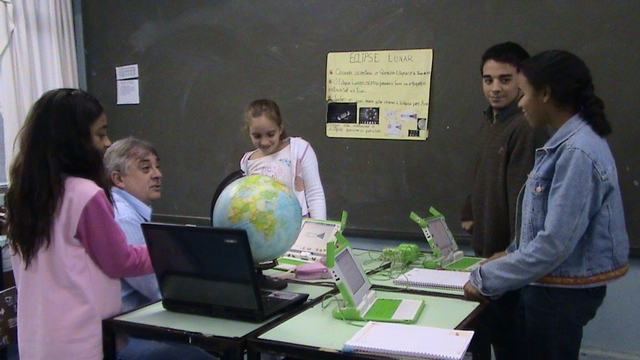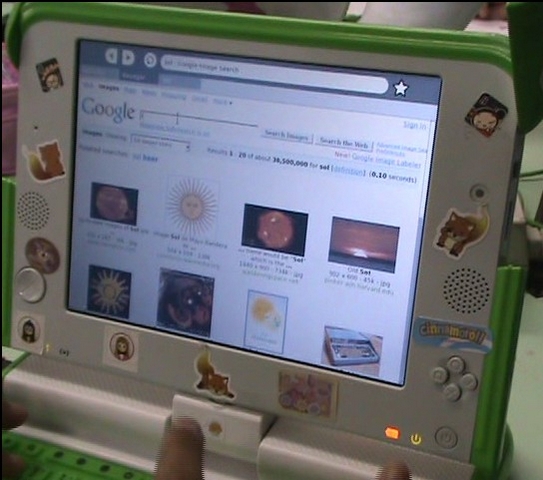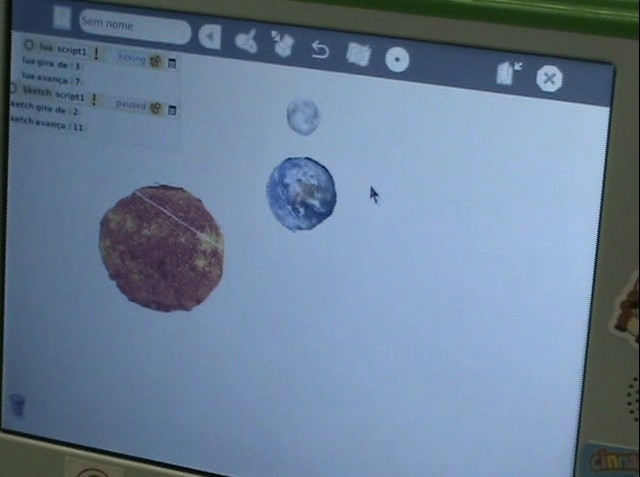[NOTE: Content needs to be reformatted so that heading and body text matches the other articles. I applied heading 1 to the heading, but it doesn't quite work here. Ditto for normal text for the body text -- it should be smaller and left-justified. Thanks -- Cathy Ginther]
Exploring Etoys in Brazil
Greetings from Porto Alegre, Brazil. I am Bruno Sperb, member of the LEC's team (UFRGS). We have been using Etoys since mid-2007 (see students' initial exploration), when the OLPC Pre-Pilot Project (iProjeto Pré-Piloto UCA, part of the National UCA Project, in Portuguese) began. Our team is supporting the experiment in Escola Luciana de Abreu (see introductory video), a small school of 350 students where all the students and teachers receive their own XO laptops for use in school and at home.
At present, we are working with small groups in weekly learning workshops (although the teachers and students use Etoys regularly in the classroom). One day, a teacher told us that three girls in the fourth grade asked her to have "Etoys time" (as they called the workshops). They were working on a project titled "How the Lunar Eclipse Works". They had already presented their project, but they were a bit frustrated with the results, so they wanted to use some of the Etoys tools and make the presentation again (in fourth grade, students present their projects regularly).
We started with their main project questions, which elicited many additional questions, doubts, and hypotheses: "Does everybody on Earth see an eclipse when it occurs?"; "What is the distance between Earth and the moon?"; "What are their differences in size?"; and more. After that, we worked with them on how to use Etoys to enhance their projects. Then we started thinking with them: how can we use Etoys for that? Had they heard of something? Had they seen something and wanted to do like it? Had they thought of anything? And so on ... It became clear then that these girls had learned some things from their colleagues' presentations, so they had some idea of what they wanted to do in Etoys. Two of them decided to design an interactive presentation for their classmates. The third girl decided to simulate the interaction of movements among Earth, the moon, and the sun.

The two girls had seen an animated drawing of their colleagues, but how could they do that by themselves? For that, besides having to think of a cool thing for others to interact with, they had to find a way to build the right scripts, to connect the parts of the whole picture, and mainly to program the objects they wanted. They ended up using the test tool, which led them to if/then language.

As for the other girl, while she was doing her project, she started thinking about how to represent the planets in the computer in a cool way (she found that her simple drawing was not enough). And she wondered how to give them the right proportion. She searched the Web for information about the sizes of and distances between Earth, the moon, and she used graphic tools in Etoys to edit and arrange them.



Sometimes, the kids got stuck or lost confidence because they were thinking that there is only one right way to do something. It is important to point out, as we are doing with the kids - and many times learning with them as well - that in Etoys, there are many ways to do something.
Using Etoys allowed the students to challenge their previously held assumptions about not only the eclipse and solar system (especially those relating to relative proportions and movements) but about their knowledge of Etoys and "how-to". At the end of the meeting, they were proud of their work: R. (9 years old) exclaimed, "It looks like a simple drawing, but when you put the cursor on it ... surprise!"
LEC Project Team (LEC/UFRGS - Porto Alegre/RS/Brasil - www.lec.ufrgs.br)





